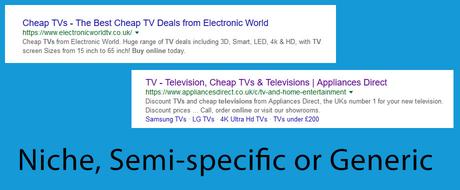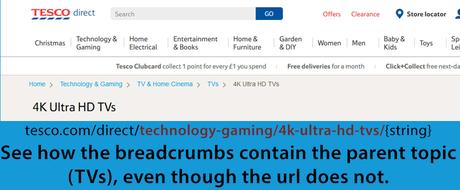Url Structure - Understanding Levels and Siloing
Now at this point you should have a list of keywords, with related user intent, and a list of categories plus the way those categories should look.
The next step is to decide the appropriate url structure for your ecommerce site.
This has to do with thematic relevance, starting with the general theme of your domain name, which will help to deduce how the rest of your site should be.
General Shop or Niche Relevant Store
The first step is to decide whether or not your site is hyper relevant to a specific product type, or whether it's more general in its targeting.
For example, if we search for the keyword "buy tvs online" in the UK, you will notice two different types of sites.
One is Appliances Direct, who like the name suggests are focused on a wide range of different electronic appliances, with TVs being one of them. They have their TV sub page ranking for this keyword.
The other is Electronic World TV, who are clearly all about TVs, with their homepage ranking for this core keyword.
So in our example Electronic World TV would be a "niche specific store", whereas Appliances Direct would be a "general store".
The Core Theme of Your Domain - Homepage
This will be the keyword we use to target for your homepage.
For a niche specific store, this will most likely be the highest volume keyword that you've done in your research, the "ultimate dream" keyword, where the top 10 is authority sites of your niche (or more general authorities).
Your homepage will be targeting that keyword + main variations (where similar topic pages show in Googles top 3), alongside the qualifying keywords like "buy, UK/USA, online, direct, for sale" etc.
For general stores, this will in contrast be a more general keyword, along with your brand name. In some cases this general keyword won't have much volume and/or buyer intent, but that's ok because we will target the main keywords with sub-pages.

Topical Clusters - Categories / Sub-categories
The next stage is to arrange your categories.
As a general SEO rule, the closer the page is to the root domain in the url, the better chance it has of ranking (better click through rates, flatter structure, etc).
However when you silo topics together, they can benefit from a ranking increase too.
So you have to find the balance, and then compensate with good internal linking.
Niche Store Categories
With niche stores it's a little more simple.
If for example your homepage and site is all about tvs, then you simply need to take all of your keyword groups, and make a category about them from the homepage, for example:
- domain.com/sony-tvs
- domain.com/32-inch-tvs
- domain.com/4k-tvs
The navigation will link to each one of these, and the homepage will have links in the content (banners or text links) to each one of these also.
Each page will be fully optimised for the user intent, and linked to using relevant anchor text.
General Store Categories
The structure for a general store ends up being slightly deeper, with a top level category for the product type, followed by the more specific pages for variations.
In our TV example, we could have the top level category for televisions looking like this:
Or alternatively they could look something like this:
- domain.com/electronics/tvs
This choice will often depend on how general your niche really is.
For example if you cover such a broad area of topics then it's important to categorise these into specific silos, in our example electronics would be a silo, containing sub-categories like cameras, tvs, computers, etc. It might also have a "home" category, containing sub-categories such as kitchen, bathroom, etc.
But if your entire website is about electronics, then you wouldn't need to further categorise before you had your cameras, tvs, etc, so they can stay next to the root domain.
The difference between the two will affect your choice of sub-category structure.
Sub-category Structure
Depending on your choice of initial categories, your sub-category structure will often differ.
If you've gone with domain.com/tvs, the it's natural to have your sub-categories like this:
- domain.com/tvs/sony-tvs
- domain.com/tvs/4k-tvs
However if you've used the category structure of domain.com/electronics/tvs, then your sub-categories can get away with being like this:
- domain.com/electronics/sony-tvs
- domain.com/electronics/4k-tvs
However when using this second structure, you must ensure your breadcrumbs are properly assigning value to the main page for the topic, so in our example the domain.com/electronics/tvs page should be in the breadcrumb trail, even though it isn't in the url.
You can see this across many site examples, such as PC World, and Tesco, as it minimises the chance of the sub-categories ranking for the main keyword (which would be keyword cannibalisation, more info here).

Product Url Structure
Like mentioned above, the closer a page is to the root of the domain in the url structure, the better it should be able to rank.
However from a user experience perspective being able to navigate to the categories of that product can help users find something similar.
So the ideal situation is to have the structure for products as follows:
In our TV example, it could look something like this:
- domain.com/lg-43-smart-4k-ultra-hd-led-tv
However, similar to the sub-category example above, all of the breadcrumbs would still appear as if the product was located at domain.com/category/sub-category
This allows users to navigate up to compare prices, or if a product is out of stock for them to find one that isn't.
As well as this, it prevents duplicate content issues when products are in multiple categories, as they will always canonicalise to the root version.
It also has the benefit of providing the breadcrumb snippets within Google, increasing the click through rate of your results.
Final Thoughts
This process can involve a little bit of trial and error. You may also end up with a lot of redirects if you do this on an existing store at scale, which can cause a temporary drop in rankings.
However in the long run it will increase your organic search visibility, and should also increase sales as a result.
Agree?
Disagree?
Need a question answering?
Comment below! Or alternatively you can email me: [email protected]

